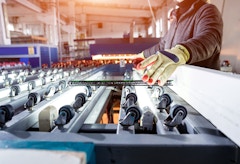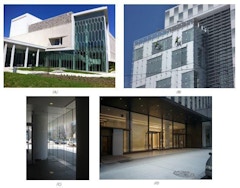
458 results
-
 Glass is a key component in building design. Benefits of utilizing Insulating Glass Units (IGUs) within a building facade are well understood,…
Glass is a key component in building design. Benefits of utilizing Insulating Glass Units (IGUs) within a building facade are well understood,… -

Coupling Facade and Structure
- Paper by Trevor Stephen Lewis, PhD, PE · Jessica Chen, PE
Traditional approach for engineering the facade is building an isolated analysis model. However, it inhibits a dynamic design process where
-

Structural Skin: Integrating Structure and Cladding
From gothic masonry to the sculptural building facades of today, exposed structural surfaces are often the most defining element of architecture. Increasingly, however, designers sit at a nexus of these aesthetic considerations and performance-driven design.
-
Laminated Security Glazing
- Paper by Vaughn Schauss,
Glass is an essential component for any type of building. Its transparency enhances daylighting and provides occupants a view to the outside. Whether… -

FTI DIALOGUES: Pushing Change
- Article by Valerie Block, FTI Board of Directors
Pushing Change: R&D Innovation Processes in Construction Building Products, the second installment of the FTI Dialogues: Suppliers & Contractors Series, took place virtually on Friday, March 26th.
-

Two Sides to Sustainability & High-performance
- Paper by Brian Fraumeni · Julia Ragragio Ruiz, LEED AP BD+C · Adam Moqrane
High performance can be defined as “a building that integrates and optimizes all major high-performance building attributes, including energy
-

Episode 09: Ted Kesik on SKINS
- Podcast by Ted Kesik, PhD
Special guest Ted Kesik, PhD, Professor of Building Science at the University of Toronto, joins us to discuss everything from digital workflows and durability to embodied carbon and resilience.
-
Glass Strength Under Point Loading
- Paper by Joshua Schultz, Ph.D, P.E., LEED AP, ENV SP · John Knowles, PE SE · Kedar Malusare
Structural glass is used in a range of building applications, and while the ASTM E1300 has recently been updated to provide a design method to
-
Introducing FacadeRetrofit.org
- Press Release
Los Angeles, CA – July 16, 2015 - While most of the green building dialog focuses on new construction, many have recognized that the fastest and most effective way to improve energy efficiency of the building sector is by remedying our existing building stock.
-
Interstitial condensation risk assessment
- Paper by Jelle Langmans · Piet Houthuys · Wout Parys · Staf Roels
The development of methods to predict and control moisture accumulation in building envelopes has always been a key element in building science.
-
Delivering Beauty
- Paper by Michael Mulhern,
Amidst the critical conversations about the need to build better and more efficient building skins, designers are also mindful of the need for the… -

Towards Net Zero Enclosures
- Paper by Jessica Santonastaso, AIA, Architect, Associate Alan Estabrook, AIA, Architect, Associate
As architects and designers we understand the urgency of addressing the building sector’s role in the ongoing environmental crisis. Architecture2030… -

Xilinx Case Study
- Paper by Michael Martinez, LEED AP, Stet Sanborn, AIA, LEED AP, CPHC,
The transformation of a dark and inhumane 1970s tilt-up concrete office building into a high performance, light-filled modern workplace was enabled… -
Terracotta 1912 to 2018
- Paper by Carol Loewenson, FAIA, LEED AP · Stephen Dietz, AIA, LEED AP
Center Three is a 100-year-old, one million square-foot building in Long Island City, New York that was constructed over the course of one year. It
-
Facade Embodied Carbon Reduction Strategies
- Paper by Isabelle Hens, LEED AP BD+C, WELL AP
Facades are increasingly being recognized as a major contributor to whole-building embodied carbon. While designers know how to reduce the embodied
-

The Carbon Footprint of Aluminum Fenestration
- Paper by Tom Bougher, Director of Applied Research Richard Braunstein, Vice President of R&D
The historical focus on reducing the carbon footprint of a building has recently shifted to include more emphasis on embodied carbon, the carbon… -

Simulation vs. reality: Measurement and verification
- Article by Stephen Montgomery · Lori O'Malley
This article explores the need for measurement and verification of building envelope and mechanical systems.

